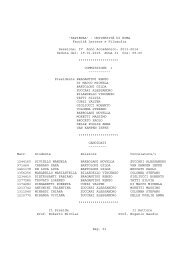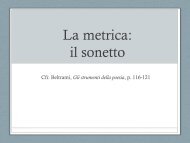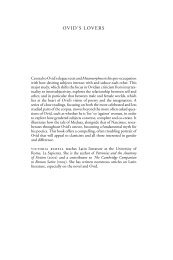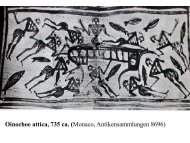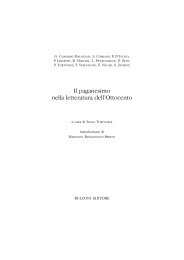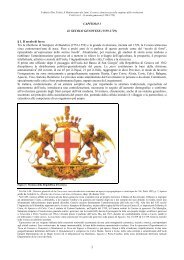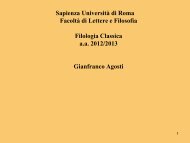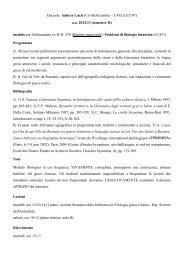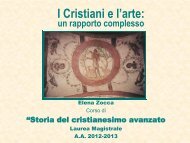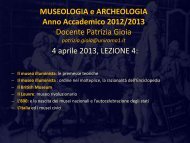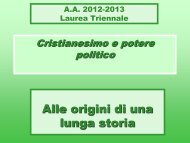Introduction to Stylistics Week 2.pdf - Lettere e Filosofia
Introduction to Stylistics Week 2.pdf - Lettere e Filosofia
Introduction to Stylistics Week 2.pdf - Lettere e Filosofia
Create successful ePaper yourself
Turn your PDF publications into a flip-book with our unique Google optimized e-Paper software.
In English almost any noun can be verbed By affixation:She (Margaret Thatcher) handbagged herEuropean counterparts.(The Guardian)By functional conversion (e.g. From noun <strong>to</strong>verb):I decided <strong>to</strong> <strong>to</strong>othbrush my way in<strong>to</strong> thebathroom.
Invent for yourself some sentences thatprovide functional conversions for thefollowing words:flower (convert it in<strong>to</strong> a verb)hear (convert it in<strong>to</strong> a noun)
We were <strong>to</strong>ld <strong>to</strong> flower the wholegarden.Everyone was upset at school so weorganised a group hear.
But there are lots of other ways of creating new words, orneologisms. Here are some examples: Take two existing words and run them <strong>to</strong>gether:'The forgettle‘: 'the forget kettle' - the kettle you could forgetabout, as it would not carry on boiling if you didn't switch it off Use the name of the person who spotted or invented the objectconcerned:‘Hoover’, the most common word meaning 'vacuum cleaner‘form J. Edgar Hoover Use a derivational form with a proper name:'Thatcherism', 'Reaganism'And two more examples: Elaversion: Avoiding eye contact with other people in an eleva<strong>to</strong>r orlift. Hicgap: The time that elapses between your hiccups going away andyour noticing that they have.(David Crystal, Language Play)
One of the ways we can express complex ideas andsets of relations is <strong>to</strong> use sentences containing themajor word-classes:(Mary) (kissed) (John) (passionately)N V N ADV(clause) (clause) (clause) (clause)(Quickly) (Mary) (became) (amorous)ADV N V N(clause) (clause) (clause) (clause)
However, in spoken language, sentences can beeven more complex since clauses can be filled bygroups of two or more words, which are calledphrases (but they function exactly the same way assingle words):(The beautiful woman) (has kissed) (the hopeful man) (very passionately)NOUN PHRASE (NP) +VERB PHRASE (VP) + NOUN PHRASE (NP) + ADVERB PHRASE (AdvP)(clause) (clause) (clause) (clause)(Very quickly) (the girl) (was becoming) (extremely amorous)ADVERB PHRASE (AdvP) + NOUN PHRASE (NP) + VERB PHRASE (VP) + ADJECTIVE PHRASE (AdjP)Note that the words in bold are defined as HEADWORDS (they must be always present while the restis optional)
Look at the titles below and discuss with yourpartner(s) what sort of phrase they are (NP, VP,AdjP, AdvP):The French Lieutenant's Woman (title of a novelby John Fowles)Going (poem by Philip Larkin)Here (poem by Philip Larkin)The Family Man (film starring Nicholas Cage)
The French Lieutenant's Woman (A noun phraseNP)Going (A one-word VP)Here (A one-word AdvP)The Family Man (A noun phrase NP)Now can you think of any other example andexplain it?
(1) NOUN PHRASE (NP) = a group of words that hasa NOUN as its head (as its most important word)and which functions <strong>to</strong>gether as a noun: a studentthe charming studentthat little Linguistics student with dark hair(2) VERB PHRASE (VP) = a group of words that hasa VERB as its head and which functions <strong>to</strong>getheras a verb: workedhad workedhad been workingmight have been working
(3) ADJECTIVE PHRASE (AdjP) = a group of words that has anADJECTIVE as its head and which functions <strong>to</strong>gether as anadjective: despicableabsolutely despicableas despicable as possible(4) ADVERB PHRASE (AdvP) = a group of words that has anADVERB as its head and which functions <strong>to</strong>gether as anadverb: quickly<strong>to</strong>o quicklymuch <strong>to</strong>o quicklyRemember: there is also a word class preposition <strong>to</strong> define thefifth kind of phrase, PREPOSITIONAL PHRASE (PP) = A group ofwords that consists of a preposition followed by a Noun Phrase: in the basketup the roaddown his throat
Daylong this <strong>to</strong>mcat lies stretched flatAs an old rough mat, no mouth and no eyes.Continual wars and wives are whatHave tattered his ears and battered his head.Like a bundle of old rope and ironSleeps till blue dusk. Then reappearHis eyes, green as rings<strong>to</strong>nes: he yawns wide red,Fangs fine as a lady's needle and bright.A <strong>to</strong>mcat sprang at a mounted knight,Locked round his neck like a trap of hooksWhile the knight rode fighting its clawing and bite.After hundreds of years the stain's thereOn the s<strong>to</strong>ne where he fell, dead of the <strong>to</strong>m:That was at Barnborough. The <strong>to</strong>mcat stillGrallochs odd dogs on the quiet,Will take the head clean off your simple pullet.Is unkillable. From the dog's fury,From gunshot fired point-blank he bringsHis skin whole, and wholeFrom owlish moons of bekitteningsAmong ashcans. He leaps and lightlyWalks upon sleep, his mind on the moonNightly over the round world of menOver the roofs go his eyes and outcry.(Ted Hughes, Esther's Tomcat)
NOUN PHRASES: this <strong>to</strong>mcat, the knight, skinwhole, the quiteVERB PHRASES: have tattered, will takeADJ PHRASE: stretched flat, green as rings<strong>to</strong>nes,blue, odd, fineADVERB PHRASES: wide red, nightly, lightlyPREPOSITIONAL PHRASE: over the roof, on thequite
Dr. Margherita Doremargherita.dore@uniroma1.it
Stylistic analysis: how (and why)writers highlight (FOREGROUND) partsof texts which are especially importantfor interpretation by breaking the rulesof language or using particularlinguistic structures more often thanwe would normally expect.The theory of FOREGROUNDING looks atwhat meanings and effects areassociated with these processes.
Linguistic DeViAtIon + Linguistic parallelismproduce the effect ofFOREGROUNDING
Brueghel’s Landscape with the Fall of Icarus1. What is the headword of the title of the painting?2. What is represented as being in the foreground of the painting?3. Where is Icarus?
Brueghel’s Landscape with the Fallof Icarus - KEY1. What is the headword of the title of thepainting? Landscape (rather than Icarus);2. What is represented as being in the foregroundof the painting? In the painting the man ploughingis in the foreground and <strong>to</strong> some extent the ship onthe right;3. Where is Icarus? All we can see of Icarus is asmall pair of legs, as he disappears in<strong>to</strong> the seanear the ship.
Musee des Beaux Arts(…)In Breughel's Icarus, for instance: how everything turns awayQuite leisurely from the disaster; the ploughman mayHave heard the splash, the forsaken cry,But for him it was not an important failure; the sun shoneAs it had <strong>to</strong> on the white legs disappearing in<strong>to</strong> the greenWater, and the expensive delicate ship that must have seenSomething amazing, a boy falling out of the sky,Had somewhere <strong>to</strong> get <strong>to</strong> and sailed calmly on.(W. H. Auden)
Deviation OCCURS when we have a set ofrules or expectations which are broken insome way.This deviation from expectation producesthe effect of foregrounding, which attractsattention and aids memorability.
Each of the lines below has a head nounmissing from a noun phrase. Fill in whatyou think would count as normal nouns:The palm at the end of the ___________Beyond the last ____________(Of Mere Being, Wallace Stevens)
The palm at the end of the mindBeyond the last thought . . .(Of Mere Being, Wallace Stevens)
Take the phrase below and fill in themissing word:a _______ ago
You probably filled the space in with a noun which canbe made in<strong>to</strong> a plural (a countable noun) and whichrefers <strong>to</strong> a period of time, e.g.:daya week agomonthyearHowever, the famous poet Dylan Thomas chose <strong>to</strong>call his poem: A Grief AgoCan you reflect on what the poet means andexplain it?
‘Yes, we went <strong>to</strong> school in the sea,though you mayn't believe it—’ (…) ‘I only<strong>to</strong>ok the regular course.’‘What was that?’ inquired Alice.‘Reeling and Writhing, of course, <strong>to</strong> beginwith,’ the Mock Turtle replied; ‘and thenthe different branches of Arithmetic--Ambition, Distraction, Uglification, andDerision.’(Alice’s Adventures in Wonderland, Lewis Carroll)
Parallelism is a local pattern used <strong>to</strong>foreground particular parts of texts andhelps us <strong>to</strong> infer new aspects of meaning.It involves two or more structures <strong>to</strong> beparallel one another, but not exactrepetitions of one another.According <strong>to</strong> Short (1996: 67) this ‘parallelismrule’ occurs when ‘readers come across parallelstructures [and] they try <strong>to</strong> find an appropriatesemantic relationship between the parallelparts’
Othello has just killed his wife, Desdemona,because of his jealousy. She is lying dead on thebed and he says:I kissed thee ere I killed thee(Othello, Shakespeare)Can you explain, using the 'parallelismprocessing rule', how this can be possible?
As you can see, this line displays a grammatically parallelpattern. It consists of two clauses which have the samegrammatical structure (subject-verb-object). ‘Kissed’ and‘Killed’ are also morphologically (Past Simple) andphonemically (/k/) and graphologically (ss – ll) parallel.These clauses are connected by means of the subordinatingconjunction 'ere'. Moreover, it is lexically parallel becausesome (but not all) of the words are repeated in similar partsof the two grammatical constructions. Apart from ‘ere’((which joins the two clauses <strong>to</strong>gether), the only wordswhich are not repeated are 'kissed' and killed'.We are therefore led <strong>to</strong> interpret Shakespeare’s 'kissed' and'killed‘ as opposites (like ‘love’ and ‘hate’ which are impliedhere).We can then conclude that parallelism can help us infer themeanings of words we don't know but also <strong>to</strong> invent new,temporary, meanings for words in context.
What we covered so far: Leech, G. N. and Short, M. H. (2007) Style InFiction, 2nd edition. London: Longman (Study Ch.1, 2) L. Wright, J. Hope, <strong>Stylistics</strong>, 1996 (Study Ch. 1, 2,3) C. Gregoriou, English Literary <strong>Stylistics</strong>, 2009(Study Ch. 1, 2) Simpson, P. (2004) <strong>Stylistics</strong>: A Resource Book forStudents. London: Routledge. (Study Sections A1-A6)



